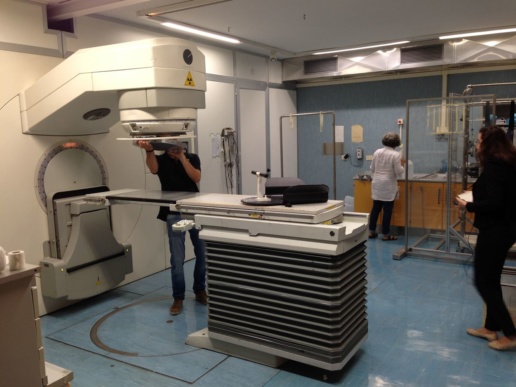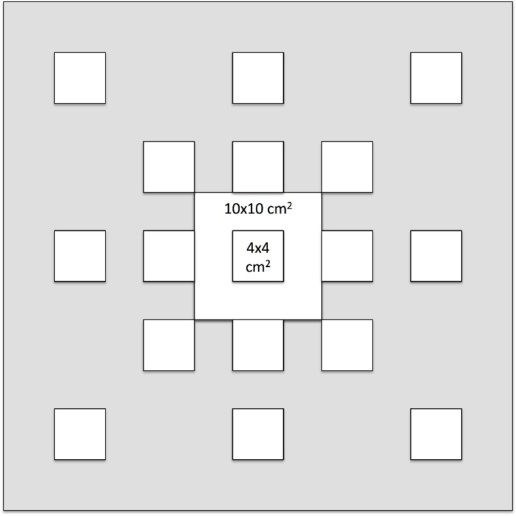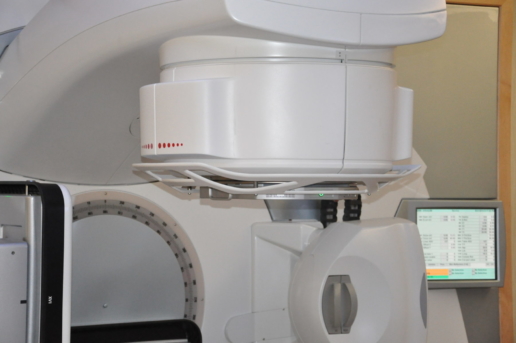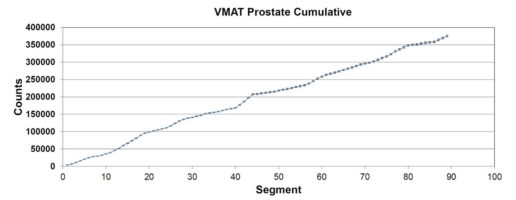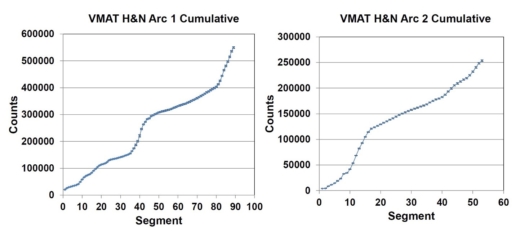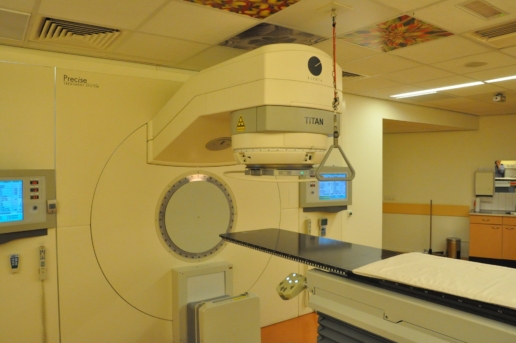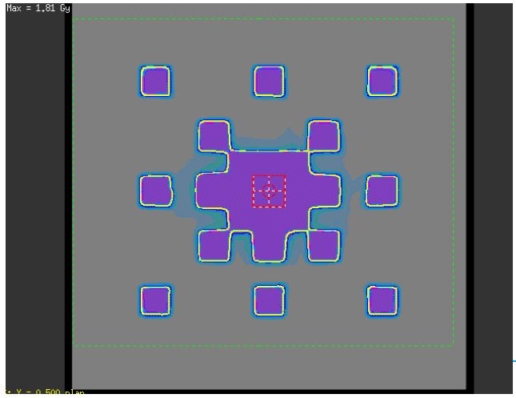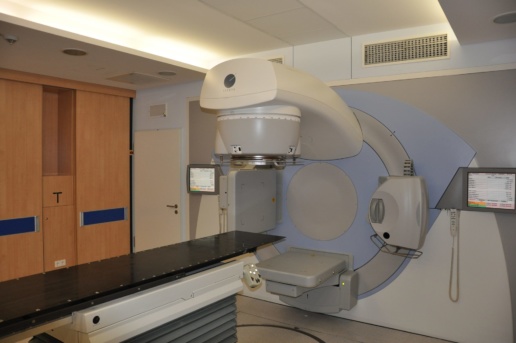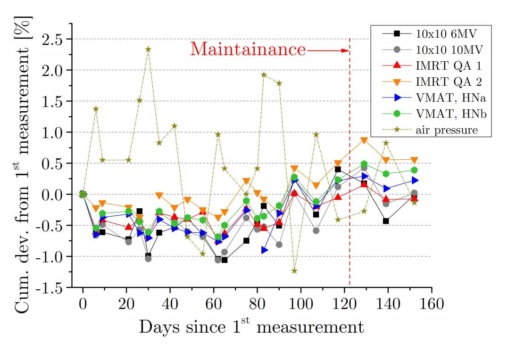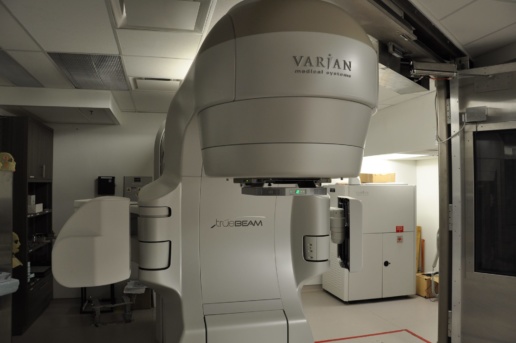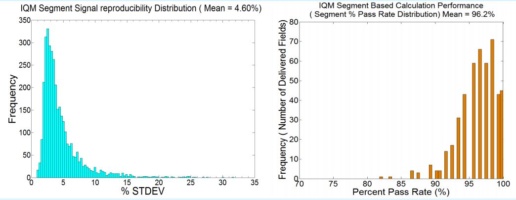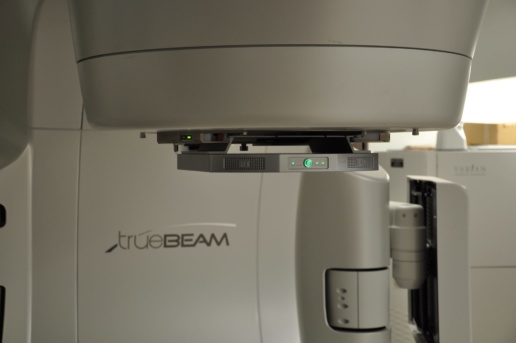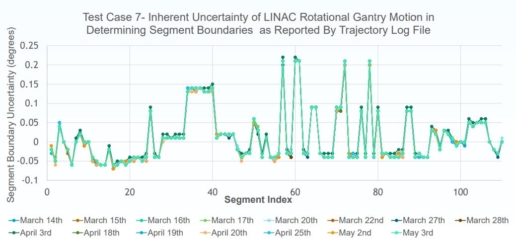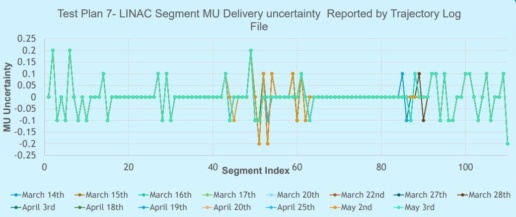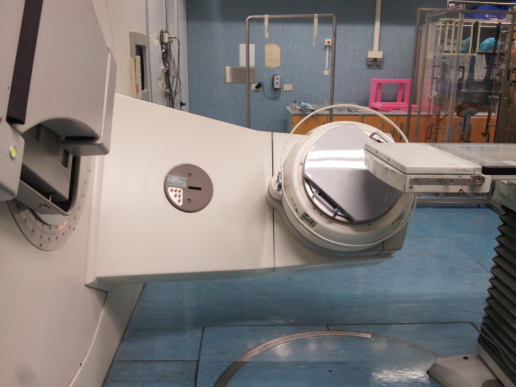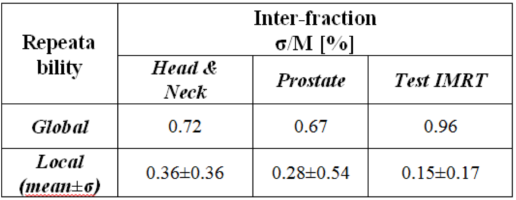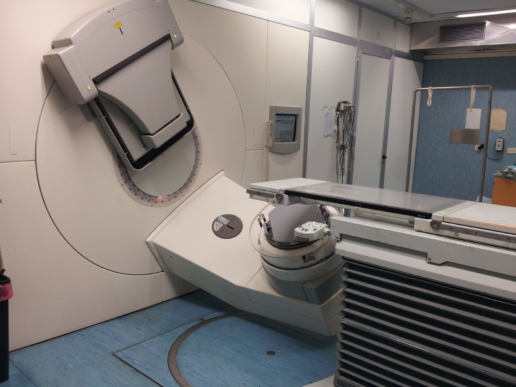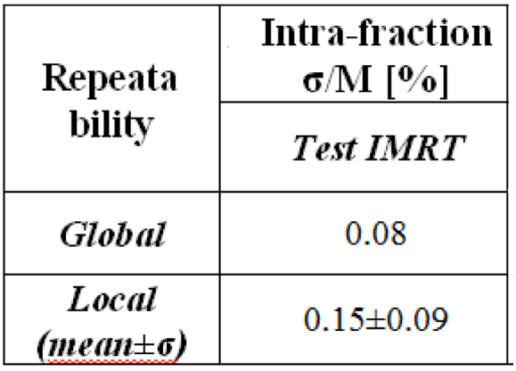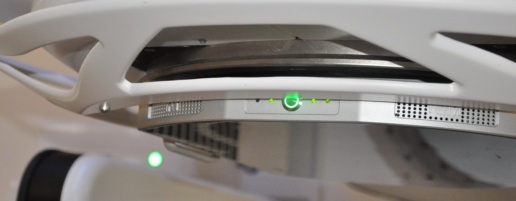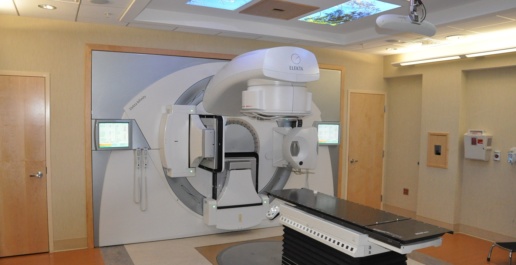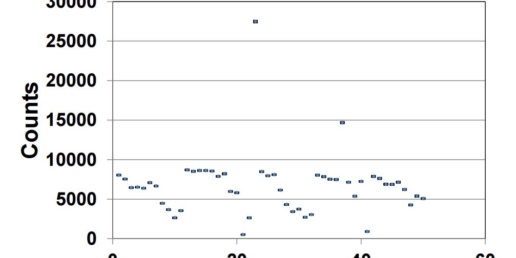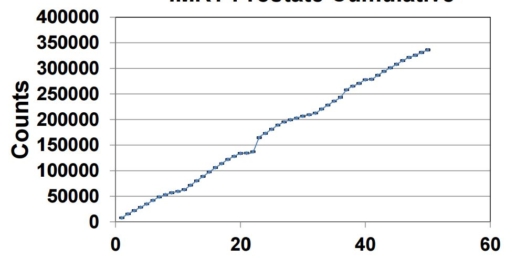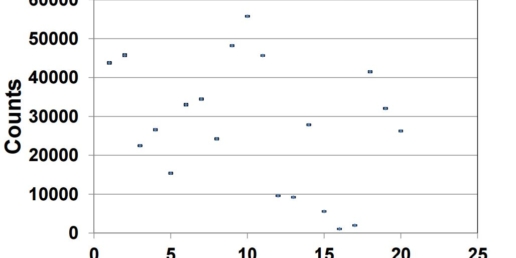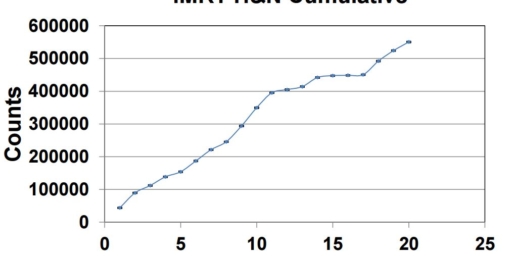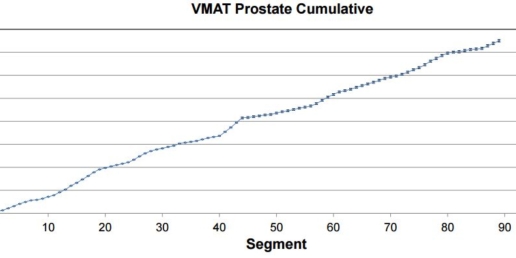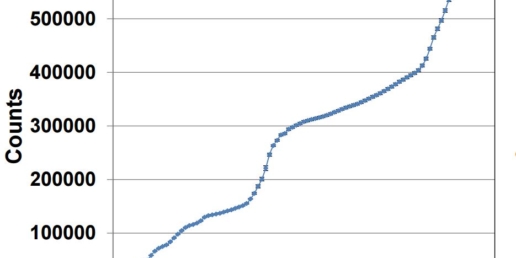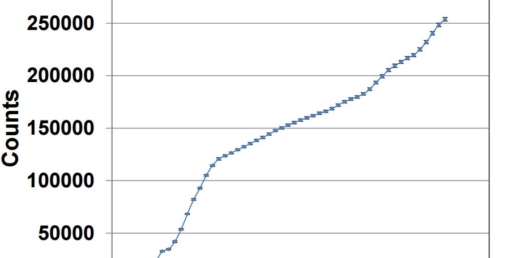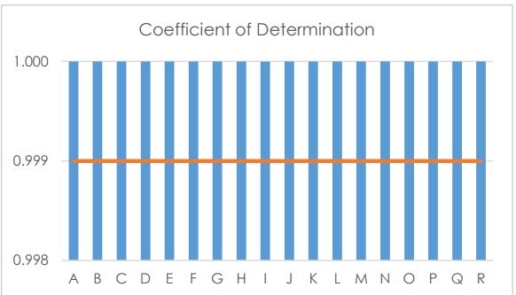Signal reproducibility
Test purpose
The aim of this multi-centre study was to test the ability of the system to detect small delivery errors in IMRT plans. This initial test in the study evaluated the short-term and long-term reproducibility of IQM measurements, because the research team considered strong reproducibility a basic requirement for any further analysis.
Test method
The short-term reproducibility was verified by delivering a test plan 15 consecutive times, over approximately 2 hours. The test field is a 6MV IMRT treatment field (treatment A) composed of 18 segments (17 4x4cm2 and one 10×10 cm2 field) (see figure 1). The output signal was analyzed segment by segment (local reproducibility) and for the entire field (global reproducibility).
The long-term detector reproducibility was evaluated by delivering three 6MV IMRT plans (A, B and C) at least 72 times each over a period of 30 days. Plans B and C are clinical plans for H&N and prostate treatment, respectively.
Test results
The signal short-term reproducibility is well within 1% (0.08% global, 0.15% local); the signal long-term reproducibility is within 1% for all beams. The detector was found to be highly reproducible, thus allowing small uncertainty levels on detector readings.
Conclusion
This test demonstrated the IQM system’s high short-term and long-term reproducibility. The larger multi-centre study found that the IQM system is capable of detecting small delivery errors in MU and leaf positions and shows a high sensitivity for clinical practice.
This test report is based on a publication created by Careggi University Hospital Florence (Italy).
Please click on the „More information“ link to access the publication website.
Signal constancy for IMRT and VMAT QA
Test purpose
Investigate the signal constancy of the IQM System for IMRT and VMAT plan QA.
Test method
The stationary and rotational dosimetric constancy of IQM was evaluated, using five field IMRT and single and double arc VMAT plans for prostate and head & neck (H&N) patients.
The plans were repeated three times for each measurement over several days to assess the constancy of IQM response.
Conclusion
IQM provides an effective means for real-time dosimetric verification of IMRT and VMAT treatment delivery.
This test report is based on a publication created by Johns Hopkins University, Baltimore (USA).
Please click on the „Download“ button to download the complete publication.
Signal stability
Test results
The signal was reproducible with a standard deviation of 0.6% during the test period.
Conclusion
IQM does an excellent job in real-time monitoring of beam delivery
This test report is based on a publication created by Radboud UMC, Nijmegen (The Netherlands).
Please click on the „Download“ button to download the complete publication.
Long-term signal stability
Test purpose
Evaluate the long-term signal stability of the IQM system.
Test method
Each one 10cm x 10cm field for 6MV and 10MV, two IMRT QA plans as well as two VMAT Head&Neck plans were delivered on 160 days between October 2016 and February 2017.
Conclusion
IQM shows a good stability of the cumulative signal sufficient for clinical use.
This test report is based on a publication created by Lake Constance Radiation Oncology Center, Singen/Friedrichshafen (Germany).
Please click on the „Download“ button to download the complete publication.
Signal calculation accuracy and measurement reproducibility
Test purpose
Evaluation of the IQM signal calculation accuracy (segment-wise and cumulative) and the measurement reproducibility by utilizing a tolerance band defined for this test.
Test method
32 Head & Neck VMAT test fields (with 110 segments each) were calculated by the IQM CALC application, then delivered by a TrueBeam LINAC for 15 fractions over a course of 50 days.
IQM segment based calculation accuracy was assessed by evaluating the
% pass rate for all delivered fields. The cumulative calculation accuracy was
measured by directly evaluating the deviation in measured cumulative signal from calculation.
IQM segment based signal reproducibility was evaluated by calculating the %STDEV for all measured signals across 15 fractions. The cumulative signal reproducibility was assessed by calculating overall deviation in measured cumulative signals from calculated signal.
Test results
A total of 52800 segments were delivered and measured.
The IQM segment-wise measured signal variation is mainly a function of signal size and accelerometer accuracy. The mean %STDEV was calculated to be 4.60%. The cumulative measured signal was reproducible to within ± 1% throughout the measurement period.
Conclusion
IQM dynamic signal reproducibility per segment was within 5% of the mean value.
This test report is based on a publication created by Princess Margaret Cancer Centre, Toronto (Canada).
Please click on the „Download“ button to download the complete publication.
Definition of a segment-wise tolerance band
Test purpose
Evaluation of the IQM beam monitoring performance for the accuracy and reproducibility of LINAC beam delivery, and those of beam monitoring performance by the IQM system to define a segment wise tolerance band.
Test method
32 Head & Neck VMAT test fields (with 110 segments each) were calculated by the IQM CALC application, then delivered by a TrueBeam LINAC for 15 fractions over a course of 50 days.
Assessment of LINAC’s beam delivery reproducibility, and accuracy of the delivered MU, and start/ end segment gantry angle for each segment was done by direct comparison of Trajectory Log Files (TLF) with corresponding planned parameters.
Similarly, gantry angles determined by the IQM accelerometer were compared to those from the trajectory log files (TLF).
Test results
A total of 52800 segments were delivered and measured. TLF analysis revealed the accuracy in LINAC’s VMAT segment boundary detection and MU delivery were within 0.3 degrees and 0.2 MU respectively.
The deviations were found to be highly reproducible, reflecting on stability of the LINAC & limitations in LINAC’s control system. The IQM accelerometer rotational accuracy was found to be within 0.4 degrees.
Conclusion
The variations in segment-wise beam delivery by the LINAC, and in monitoring by IQM, should be considered when performing calculation versus measurement analysis.
The calculation model performance was found to be satisfactory for Head & Neck VMAT beam monitoring.
This test report is based on a publication created by Princess Margaret Cancer Centre, Toronto (Canada).
Please click on the „Download“ button to download the complete publication.
Inter-fractional signal constancy
Test purpose
Test the inter-fractional (long-term) repeatability of the IQM signal.
Test method
Inter-fraction repeatability was checked by delivering three IMRT treatments for more than seventy times in a period of thirty days. The chosen treatments were: a head & neck (H&N), a prostate and a test IMRT treatment. For each segment of the IMRT treatment sigma and M were evaluated over the number of repetitions (21 for H&N; 30 for prostate and „Test“ IMRT). In H&N and prostate tests gantry rotation and small fields of different shape and size were considered.
Conclusion
IQM provides a high long-term signal reproducibility for complex IMRT plans.
This test report is based on a publication created by University of Florence, Florence (Italy).
Please click on the „Download“ button to download the complete publication.
Intra-fractional signal constancy
Test purpose
Test the intra-fractional (short-term) repeatability of the IQM Signal.
Test method
Intra-fraction repeatability was checked by delivering 15 times (about 2 hours) the same plan, composed by 17 square fields 4 cm x 4 cm and 1 larger field 10 cm x 10 cm irradiating different regions of the detector.
Conclusion
IQM provides a very good short-term signal reproducibility for complex IMRT plans.
This test report is based on a publication created by University of Florence, Florence (Italy).
Please click on the „Download“ button to download the complete publication.
Signal constancy for clinical IMRT and VMAT plans
Test purpose
Investigation of the constancy of IQM signal for conventional intensity modulated radiation therapy (IMRT) and rotational volumetric modulated arc therapy (VMAT)
Test method
The stationary and rotational dosimetric constancy of IQM was evaluated, using five field IMRT and single- and double-arc VMAT plans for prostate and head-and-neck (H&N) patients.
The plans were repeated three times for each measurement over several days to assess the constancy of IQM response.
Test results
Repeated IQM measurements of prostate and H&N IMRT deliveries showed 0.4 and 0.5% average standard deviation (SD) for segment-by-segment comparison and 0.1 and 0.2% for cumulative comparison. The corresponding SDs of the cumulative signal for VMAT deliveries were 0.7, 1.3%, respectively.
Conclusion
IQM provides an effective means for realtime dosimetric verification of IMRT/VMAT treatment delivery.
This test report is based on a publication created by Johns Hopkins University, Baltimore (USA).
Please click on the „Download“ button to download the complete publication.
Signal linearity
Test purpose
The signal linearity test verifies that the signal detected by IQM is directly proportional to the dose output. If all other variables remain constant, the signal should double if the dose output is doubled.
Test method
The signal linearity test uses the reference field size of 10cm x 10cm
(defined by MLC and Jaws) for a 6MV photon beam. The dose output is increased through 8 measurements in the following steps:
2 MU / 5 MU / 10 MU / 20 MU / 50 MU / 100 MU / 200 MU / 500 MU
The coefficient of determination R2 indicates the variation of observed data from the line of best fit.
R2 is defined as:
1 − ??? ?? ??????? ???????? / ????? ??? ?? ???????
The signal linearity test passes if the R2 value is 0.999 or better for a linear fit equation (IQM signal vs. delivered MU).
Test measurements were performed on 18 linear accelerators.
Test results
The measured IQM Signal for all doses and the calculated coefficient of determination is listed in Table 1 and diagrammed in the Figure below with the pass criteria (orange line). Rounded to three decimal places, the R2 coefficient of determination is 1.000 for all linear accelerators, at all sites, passing the criteria of R2 at or better than 0.999.
This test report is based on a publication created by iRT Systems GmbH, Koblenz (Germany).
Please click on the „Download“ button to download the complete publication.
